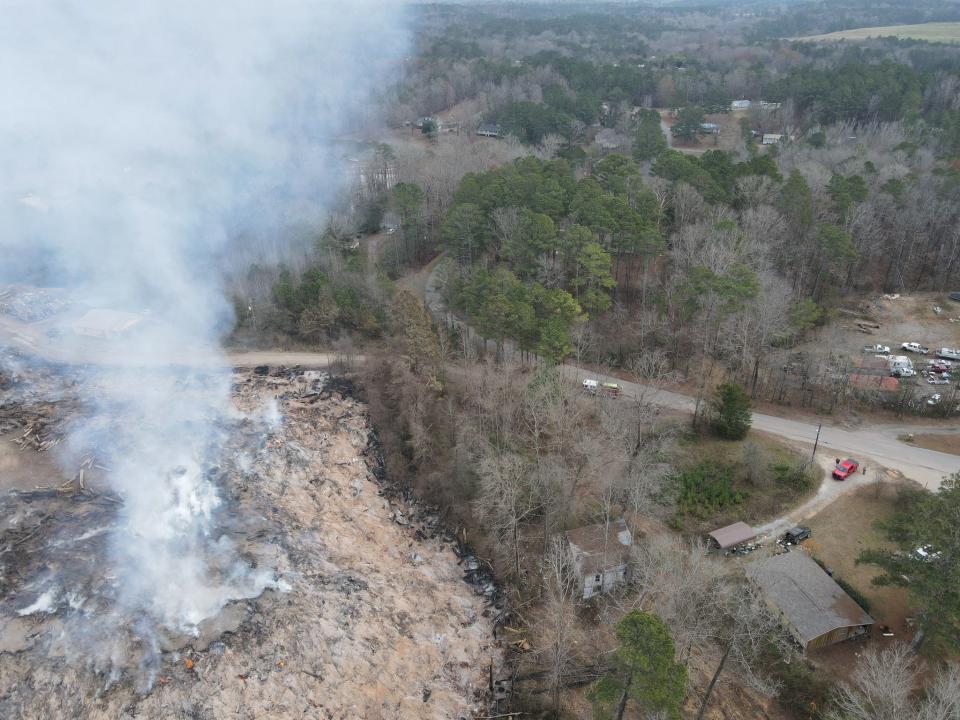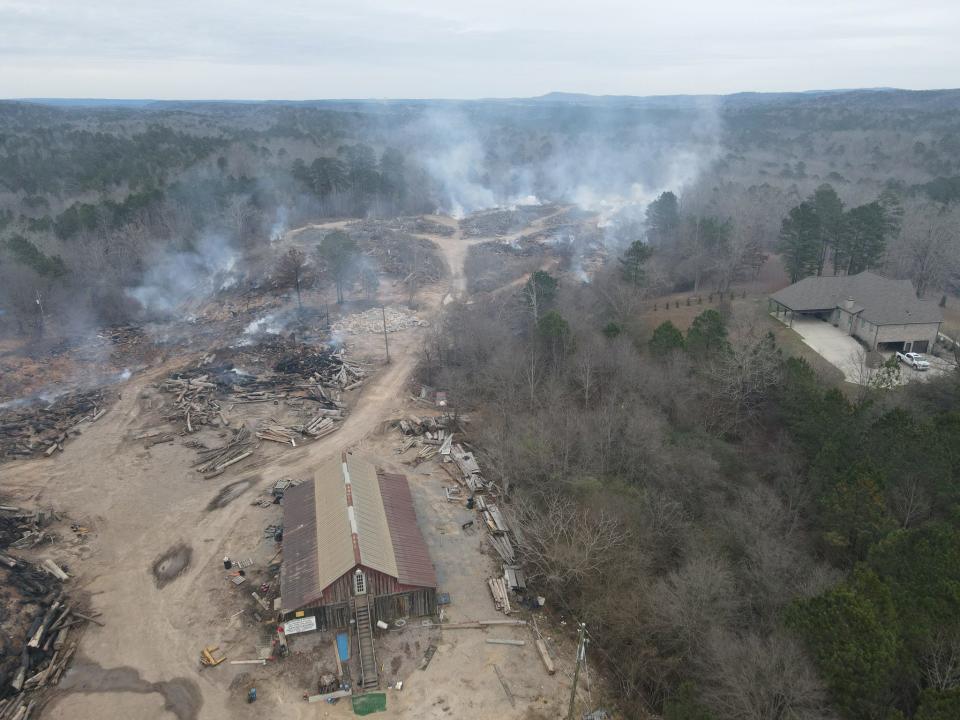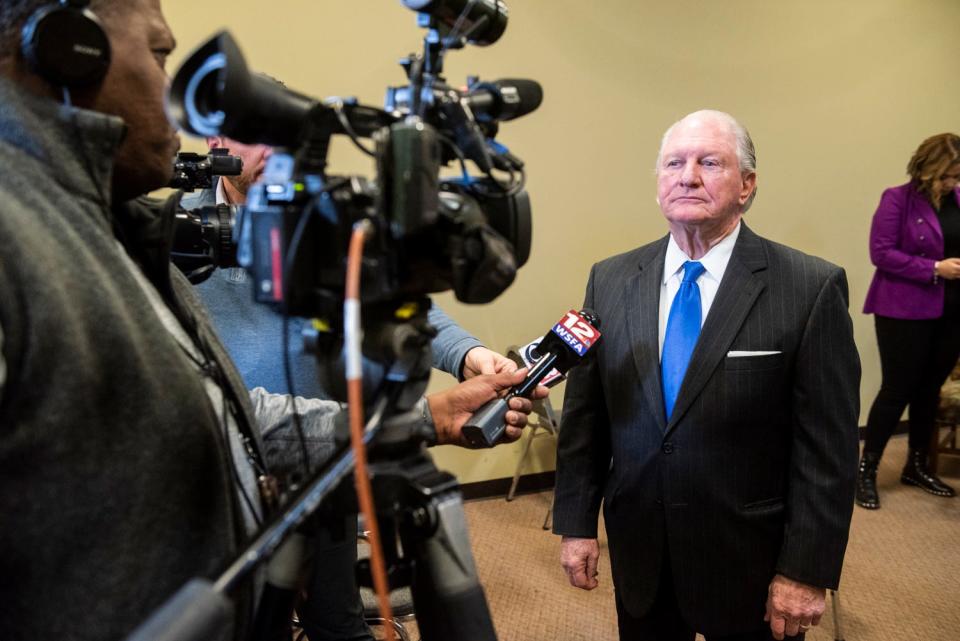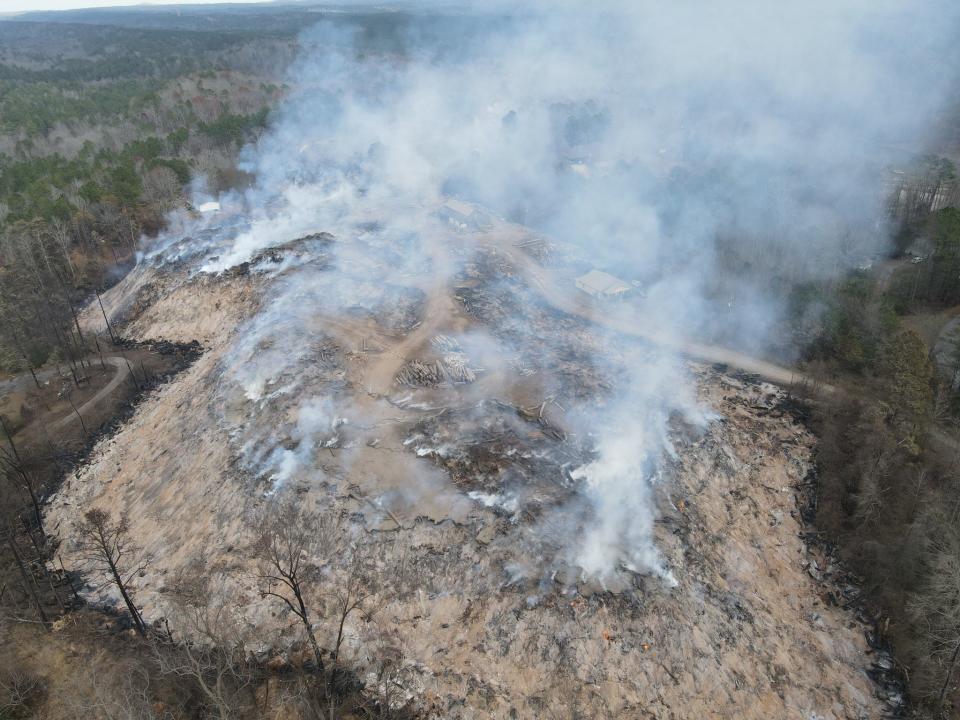Landfills catch fire, briefly, all over America. Why did one in Alabama burn for months?
An underground landfill fire in Alabama has burned for more than four months, polluting the air for miles and sickening people and animals. For weeks, state and local authorities did little to stop it, instead bickering over their responsibilities.
The site, intended to collect grass clippings and tree branches and other such waste, has been a problem for years, with state inspectors at least twice urging its private management company to close down the landfill. Yet it continued to function as a dumping ground for unsanctioned and flammable materials.
Alabama eventually called in the Environmental Protection Agency, conceding it needed help with the fire. Now that it is essentially out, as of this week, the state will soon be on its own again.
'Fix it': Residents affected by Alabama landfill fire launch protest at the State House
Three months on: Alabama landfill fire is still burning
Alabama set up a working group to address the many concerns angry area residents – some of whom live just 100 yards from the 16 1/2-acre landfill – have raised about how the fire was handled. Some have filed suit over the site, which Alabama authorities allowed to operate without a permit even as it racked violations over its operations, before ultimately exposing tens of thousands of people to toxins since the fire ignited.
Landfill fires are common; the one in Alabama was unusual
Although a monthslong fire at a dump is unusual, landfill fires are more common than most Americans likely realize, usually the result of heat buildup from decomposing garbage bursting into flames. Hundreds of blazes occur annually at waste sites, according to a federal database of fire incidents. But they rarely burn for more than a day, a USA TODAY analysis of the data found.
“Landfill fires occur at different scales across the country at a frequency people may not be aware of because they don’t get publicized,” said Matthew Huyser, the EPA's on-scene coordinator in Alabama. “Most of the time, they’re dealt with by the facility or by the (fire) department, if necessary. They can be addressed or extinguished rather quickly."
These fires don't typically occur spontaneously unless the landfill isn't properly "capped," or covered with compacted soil, to ensure that the layers of decomposing waste aren't exposed to oxygen. It's the presence of oxygen that allows for flames.
While most large landfills taking household trash require maintaining a soil cap, "this particular site is different because the state regulations did not require that," Huyser said.

That's because the site wasn't operating as a construction debris or a municipal waste landfill. Instead, the site run by Environmental Landfill Inc. was meant for disposing of vegetation, Huyser said, which does not require a cap in Alabama.
But the state's own records show the site was repeatedly used to dump construction debris, tires and other non-vegetative waste. And in the months since the fire broke out, the EPA has found enough construction demolition debris on the surface of the landfill to fill roughly three dump trucks – including scrap metal, wiring, chain-link fence, plastic, a metal beam and fence post, tire pieces and other rubbish – which it plans to transport to an approved landfill, said Subash Patel, another on-scene coordinator with the EPA.
"Those things should not have been disposed on the site," Huyser said.
A spokeswoman for the Alabama Department of Environmental Management, or ADEM, however, noted that the cause of the fire has not been determined.
Spokeswoman Lynn Battle said added that the state agency "does not have authority to regulate vegetative waste sites, and land use decisions are decided by local government, such as the county, not ADEM."
The owners of Environmental Landfill and their attorney did not respond to multiple emails, phone calls, or text messages requesting comment.
More: Justice Department sues Louisiana chemical company over high cancer risk to majority-Black community
A history of violations
The landfill, however, was hardly unfamiliar to the state agency.
The site, roughly 20 miles northeast of Birmingham, has been dinged for violations by ADEM in the past, going back nearly a decade, according to a USA TODAY review of the environmental agency's online records database.
As far back as November 2013, an ADEM inspector found unauthorized solid waste dumped at the landfill, including construction demolition waste, scrap tires and shingles.
"The disposal site does not meet the minimum requirements for a landfill unit, has not obtained a landfill permit from the department, and therefore is an unauthorized dump," the state's environmental agency wrote in a December 2013 letter to the landfill's owner. The agency urged the closure of the site and asked the owner to submit a written cleanup plan.

A similar letter was sent to the landfill's owner in 2018, citing the discovery of "construction and demolition waste, scrap tires, scrap metal and petroleum contaminated soil" and asking for a "site closure plan."
A 2020 inspection report yet again flagged similar types of trash and construction debris, such as "construction demolition waste," as well as "creosote-coated power poles and pallets." The wood preservative creosote is highly combustible and the EPA recommends it not be burned in a residential setting to keep people from inhaling toxic chemicals in smoke and ash. By August 2022, the last inspection before the November fire broke out, an ADEM inspector said the poles and pallets had been removed and taken to the appropriate landfills.
Still, the inspector noted that "tree waste was primarily observed on-site, with very little construction demolition waste observed in piles on top of tree waste."
Environmental attorney David Ludder, who served as ADEM’s general counsel in the 1980s, said the state agency has misread state statute in concluding green waste landfills don't need to be permitted, unlike other landfills.
"My analysis of the statute, which ADEM operates under, says precisely that they are supposed to regulate that disposal," Ludder said.
Ludder called the landfill fire "one of the top failures of the agency."
"ADEM has known for years that there has been other waste mixed in with the vegetative waste, but their actions have been ineffective," Ludder said. "I think the most they've done is issue a notice of violation to the company. It's basically a request for voluntary compliance. It doesn't require them to comply. It doesn't impose a mandatory duty to comply. it doesn't impose any penalties for noncompliance."
And if the landfill continued to accept unauthorized materials, they should have been forced to obtain a permit under ADEM's existing interpretation of the statute, said Michael Hansen, executive director at the Greater Birmingham Alliance to Stop Pollution, or GASP.
In February, ADEM Director Lance LeFleur told the state's Environmental Management Commission that the fire had "exposed shortcomings" in the ability of state and local governments to respond to such situations that pose a risk to the public.
"ADEM will investigate and take appropriate enforcement action against the site operator after the fire is out," LeFleur said

Where will you find 'forever chemicals'? Everywhere, new analysis suggests.
Lawsuits allege negligence
Two lawsuits have been filed in the Circuit Court of St. Clair County, Alabama, alleging that Environmental Landfill, and its owners were negligent in their operation of the landfill, among other issues. One of the lawsuits is a class-action complaint; the other lawsuit also names LeFleur in his official and individual capacity.
Tens of thousands of people were exposed to harmful levels of toxic air pollution as state and local agencies spent weeks pointing fingers at each other, trying to determine who was supposed to do what, Hansen said.

"Initially, ADEM simply issued a couple of statements and passed the buck elsewhere," Hansen said. "They offered no real guidance to the impacted residents looking for answers and action. Gov. Kay Ivey did nothing up until the very last minute when she finally declared a state of emergency."
Ivey, a Republican, declared a limited state of emergency in January, allowing local firefighters to intervene on private property and so she could ask the EPA for help.
Emergency declared: Ivey calls on EPA to fight landfill fire raging in Alabama
Meanwhile, residents have reported headaches, coughing, wheezing, nausea, nose bleeds, vomiting, eye and throat irritation, rashes, loss of appetite, difficulty breathing and more, Hansen said. Outdoor animals including dogs showed signs of distress and had to be brought indoors, he said.
Last month, the state created a working group to examine "shortcomings" in how the state and local governments responded to the fire. The group is expected to make recommendations on whether changes to state law or additional resources are needed.
The EPA plans to have a team available with a water truck and excavator at the site if needed for roughly two more weeks and the state and county are expected to take the lead around mid-April, the EPA's Patel said.
As for the landfill, it's unclear if it will ever be reopened for vegetative waste.
"I'm hoping ADEM, the county, and the owner will reach an agreement where there will be no further action at the landfill," Patel said. "It will be up to those three parties to decide how they want to move forward."
Follow Tami Abdollah on Twitter @latams or email her at tami(at)usatoday.com
This article originally appeared on USA TODAY: Landfills burn all over America. But in Alabama, one burned for months

